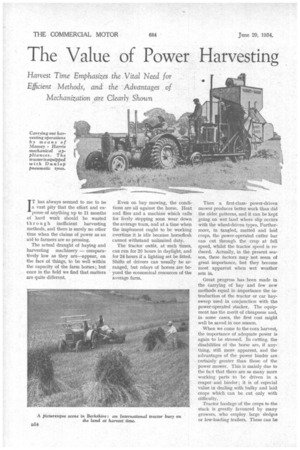The Value of Power Harvesting
Page 108

Page 109

If you've noticed an error in this article please click here to report it so we can fix it.
Harvest Time Emphasizes the Vital Need for Efficient Methods, and the Advantages of Mechanization are Clearly Shown IT has always seemed to me to be a vast pity that the effort and expense of anything up to 11 months of hard work should be wasted through inefficient harvesting methods, and there is surely no other time when the claims of power as an aid to farmers are so pressing.
The actual draught of haying and harvesting machinery — comparatively low as they are—appear, on the face of things, to be well within the capacity of the farm horses ; but once in the field we find that matters are quite different. , Even on hay mowing, the conditions are all against the horse. Heat and flies and a machine which calls for lively stepping soon wear down the average team, and at a time when the implement ought to be working overtime it is idle because horseflesh cannot withstand unlimited duty.
The tractor outfit, at such times, can run for 20 hours in daylight, and for 24 hours if a lighting set be fitted. Shifts of drivers can usually be arranged, but relays of horses are beyond the economical resources of the average farm.
Then a first-class, power-driven mower produces better work than did the older patterns, and it can be kept going on wet land where slip occurs with the wheel-driven types. Furthermore, in tangled, matted and laid crops, the power-operated cutter bar can cut through the crop at full speed, whilst the tractor speed is reduced. Actually, in the present season, these factors may not seem of great importance, but they become most apparent when wet weather sets in.
Great progress has been made in the carrying of hay and few new methods equal in importance the introduction of the tractor or car haysweep used in conjunction with the power-operated stacker. The equipment has the merit of cheapness and, in some cases, the first cost might well be saved in one season.
When we come to the corn harvest, the importance of adequate power is again to be stressed. In cutting, the disabilities of the horse axe, if anything, still more apparent, and the advantages of the power binder are certainly greater than those of the power mower. This is mainly due to the fact that there are so many more working parts to be driven in a reaper and binder ; it is of especial value in dealing with bulky and laid crops which can be cut only with difficulty.
Tractor haulage of the crops to the stack is greatly favoured by many growers, who employ large sledges or low-loading trailers. These can be
quickly loaded with little labour and the sheaves can be placed on the body without the services of a man loader, by those pitching from the ground level.
Where stacking in the field is practised, a large area can be • quickly and cheaply cleared. Under dry conditions, the crop can, of course, be threshed in the field and only the straw stacked. An elevator is needed for this work either event, Before leaving the question of'harvesting I should like to draw atten
in lion to that most valuable feature of the tractor, namely, its ability to carry out rapidly a thorough cultivation of the stubble. By thiS means, in a favourable month, it is possible to cut up the stronger perennials, to bring up couch to the surface, where it may be gathered and burned, and provide a seed bed wherein the seeds annuals, such as poppies and charlock, may
be encouraged to germinate, and where the resultant seedlings may be destroyed. D.N.Mals
































































































































































